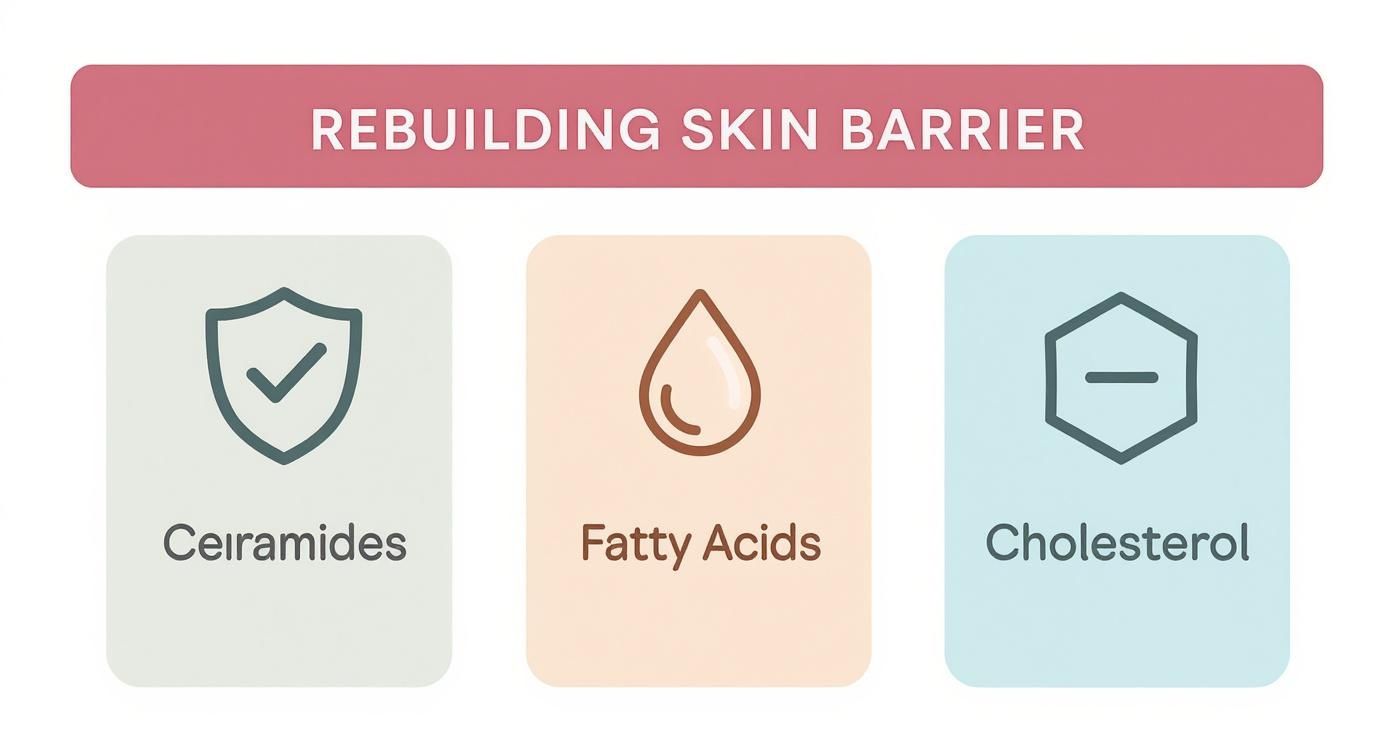If you've ever found yourself asking, "why is my skin so dry all the time?" the answer almost always comes down to one thing: a compromised skin barrier. Think of it as your body's first line of defense. When it's strong, it keeps the good stuff in and the bad stuff out. But when it weakens, everything goes a bit haywire.
That tight, flaky, and downright uncomfortable feeling is the direct result of this barrier breaking down. It's the real root cause of persistent dryness.
Understanding Your Skin’s Protective Shield

Your skin's outermost layer, known as the stratum corneum, acts like a diligent security guard. Its job is to lock in hydration and block out environmental troublemakers.
A great way to visualize this is to imagine a brick-and-mortar wall. The skin cells are the "bricks," and the natural fats, or lipids—like ceramides and fatty acids—are the "mortar" holding it all together seamlessly.
When that lipid mortar is healthy and abundant, your skin feels soft, plump, and happy. But when it gets depleted, tiny, invisible cracks start to form in that wall. This creates a two-pronged attack on your skin's health. First, precious moisture escapes through the gaps in a process called transepidermal water loss (TEWL). Second, irritants can now sneak in, leading to redness, sensitivity, and inflammation.
If you're struggling, you're certainly not alone. The market for dry skin treatments is expected to take up a massive 33.2% market share of the entire skincare industry by 2025. That shows just how many of us are on the hunt for real relief. You can dig deeper into these skincare market trends and their drivers to see the bigger picture.
So, what’s actually causing the damage? To figure out what's weakening your skin's defenses, it helps to look at the usual suspects. The culprits can be found both in your environment and inside your own body.
Quick Guide to Dry Skin Causes
Here’s a simple table to help you quickly pinpoint what might be contributing to your dry skin.
| Factor Type | Common Examples |
|---|---|
| External Factors | Low humidity (think winter air), harsh soaps, super hot showers, over-exfoliating, wind, and sun exposure. |
| Internal Factors | Genetics, the natural aging process, hormonal shifts (like menopause), poor nutrition, and certain health conditions. |
As you can see, everything from the weather to your daily shower habits can have an impact. Pinpointing the cause is the first step toward finding a solution that brings your skin back into balance.
How Your Environment Drains Your Skin's Moisture

While what’s happening inside your body certainly matters, the answer to "why is my skin so dry?" is often right outside your door—or even inside your home. Think of your environment as a constant challenge to your skin’s moisture, always looking for a way to steal hydration.
It’s no surprise that winter is a prime time for dry skin. The cold, crisp air outside is naturally low in humidity. When you come inside, the central heating creates an even drier, desert-like climate. This one-two punch of low humidity literally pulls moisture straight out of your skin, increasing water loss by as much as 25% in the colder months.
But summer isn't always a free pass. That blessed relief from the air conditioner works by removing humidity from the air, which has the same moisture-sapping effect as winter heating. Even on the most sweltering days, you might find your skin feeling tight and parched.
Everyday Habits That Strip Your Skin
Beyond the weather, some of our most common routines are serious culprits. These seemingly harmless habits can aggressively strip away the natural oils, or lipids, that your skin relies on to stay protected and hydrated.
Modern life itself can be a trigger. One clinical study found that people living in cities experience more skin inflammation from pollution and stress, leaving sensitive skin even more vulnerable to dryness. You can dive deeper into Galderma's study on modern living and sensitive skin to learn more.
Take your daily shower, for example. A long, hot shower might feel amazing, but it’s a brutal experience for your skin. The high temperature essentially melts away those essential lipids—the "mortar" holding your skin barrier together—leaving it weak and exposed.
Here are a few other common offenders to watch out for:
- Harsh Soaps and Cleansers: Many popular soaps use powerful surfactants that disrupt your skin’s natural pH balance. They wash away dirt, but they take all your protective oils with them.
- Frequent Hand Washing: It's a must for hygiene, but constant washing with hot water and alcohol-based sanitizers can wreck the delicate skin on your hands.
- Over-Exfoliating: Whether you're using rough scrubs or potent chemical exfoliants too often, you can physically damage your skin barrier, leading to a cycle of chronic dryness and irritation.
Uncovering the Internal Causes of Dry Skin
While the world around you certainly plays a part, the real answer to "why is my skin so dry?" often lies within your own body. Your genetics, internal processes, and even your age can profoundly influence how well your skin holds onto moisture.
As the years go by, our skin naturally slows down its production of sebum—the oily, waxy substance that acts like a natural sealant. This gradual decline is a key reason why skin tends to get drier as we get older. Hormonal changes, especially during menopause, can throw a wrench in the works, too, making skin feel parched and less supple.
Your Diet and Deeper Health Issues
It’s no surprise that what you put into your body shows up on your skin. A diet low in essential fatty acids, like the omega-3s you find in fish and flaxseed, can weaken your skin’s barrier from the inside out. Think of these healthy fats as the "mortar" holding your skin cells together, keeping them strong and hydrated.
Of course, drinking enough water is just as important, along with getting plenty of skin-loving vitamins like A, C, and E that help with protection and repair.
Sometimes, stubbornly dry skin can be a red flag for a deeper health issue. Conditions such as eczema, psoriasis, and even thyroid imbalances often show up first as persistent dryness, flaking, or irritation.
Xerotic skin—the clinical term for abnormally dry skin—is incredibly common, affecting about 30% of people. It becomes more frequent with age and is a classic sign of atopic dermatitis (eczema), a condition that impacts nearly 1 in 10 Americans. You can learn more about the prevalence and impact of dry skin conditions.
If your dry skin is severe, just won't go away, or comes with other symptoms, it’s always smart to check in with a doctor. Getting to the bottom of these internal factors gives you the power to treat the root cause of dryness, not just the flaky symptoms on the surface.
How to Rebuild Your Skin Barrier from the Outside In
So, we've covered what's breaking down your skin barrier. Now for the good part: how to fix it. Think of it like patching up that brick-and-mortar wall we talked about earlier. You can't just slap any old spackle on it; you need the right materials. For your skin, that means providing lipids it recognizes and can put to work immediately to fill in the cracks.
The whole point is to give back what's been lost. When you apply ingredients that are a near-perfect match for your skin’s natural oils, you're handing it the exact building blocks it needs to repair itself. This is why bio-compatible ingredients are a game-changer for anyone asking, "Why is my skin so dry?"
Finding the Right Ingredients
To truly mend that barrier, you need to look for ingredients that act like the "mortar" holding your skin cells together. The best choices are always going to be those rich in the same lipids your skin makes on its own.
- Ceramides: These are the undisputed champions of your skin barrier, making up over 50% of its structure. They are absolutely essential for locking everything together and stopping water from escaping.
- Fatty Acids: These are what keep your skin feeling flexible and supple. They also have a wonderful calming effect, which is a huge relief for irritated, dry skin.
- Cholesterol: Don't worry, this isn't the same cholesterol you hear about in your diet! In your skin, cholesterol is a vital lipid that helps keep the barrier strong and resilient.
By choosing moisturizers loaded with these bio-compatible lipids, you're essentially giving your skin the exact toolkit it needs to rebuild. This is so much more than just basic hydration—it's about active, structural repair that brings lasting relief.
Using these kinds of powerhouse ingredients helps calm inflammation and gives your cells the support they need to regenerate. If you want to dive deeper into what to look for on a product label, check out our guide on the best ingredients for dry skin. Ultimately, the goal is simple: replenish lost oils, seal in moisture, and get your skin's defenses back in working order.
Your Action Plan for Hydrated, Healthy Skin
Alright, now that you know what's behind your dry skin, it's time to do something about it. The best approach tackles the problem from two angles: making simple, smart adjustments to your daily life and upgrading your skincare to actively heal and protect.
The great news? You don't need some complex, ten-step ritual to see a real difference. Small, consistent changes are often the most powerful. Think of this as your practical toolkit for getting your skin back to a place where it feels comfortable, supple, and hydrated.
Simple Lifestyle Adjustments
So often, the fight against dry skin begins with habits we don't even think about. One of the biggest culprits is the shower. I know a long, steaming hot shower feels amazing, but it's a disaster for your skin's natural oils, stripping them right off. The fix is easy: turn the temperature down to lukewarm and try to keep your showers under 10 minutes.
Another game-changer, especially in winter, is a humidifier. When you crank up the heat indoors, the air becomes incredibly dry and starts pulling moisture from wherever it can—including your skin. Running a humidifier in your bedroom or office puts that moisture back into the air, giving your skin a much-needed break.
This infographic does a fantastic job of breaking down what a healthy skin barrier is really made of.

As you can see, those key components—ceramides, fatty acids, and cholesterol—are the literal building blocks for a strong, resilient barrier.
Strategic Skincare Upgrades
Beyond your daily habits, what you put on your skin is obviously critical. The single most important technique? Always apply moisturizer to slightly damp skin, preferably within a couple of minutes of getting out of the shower. This simple trick traps that surface-level water before it has a chance to evaporate, sealing in a huge dose of hydration.
To get the most out of your products, it helps to understand what you're actually looking at on the ingredient label. Moisturizers aren't all created equal; they work in different ways.
Knowing what the three main types of moisturizing ingredients do can make you a much smarter shopper.
Understanding Your Moisturizer Ingredients
| Ingredient Type | Function | Examples |
|---|---|---|
| Humectants | Act like little magnets, pulling water from the air and deeper skin layers to the surface. | Hyaluronic acid, glycerin |
| Emollients | Fill in the microscopic cracks between skin cells, which is what makes skin feel soft and smooth. | Tallow, shea butter, ceramides |
| Occlusives | Form a physical barrier on top of the skin to stop water from escaping (a process called TEWL). | Tallow, beeswax, petroleum jelly |
A great moisturizer will often contain a mix of these. The goal is to get a complete support system for your skin barrier.
When you start combining these smart lifestyle choices with the right skincare, you create a powerful, proactive defense against dryness. For a deeper dive into holistic skincare, check out our guide to a natural dry skin treatment.
Common Questions About Dry Skin Answered
Even with a solid game plan, it's natural for questions to pop up when you're trying to get to the bottom of your dry skin. Let’s walk through some of the most common ones to clear up any confusion and help you move forward.
Can Drinking More Water Alone Cure My Dry Skin?
While drinking plenty of water is fantastic for your overall health, it’s rarely the silver bullet for dry skin. The real problem usually isn't about how much water you're putting in your body, but rather your skin's inability to hold onto that moisture.
Think of it like trying to fill a bucket that has tiny holes in it. You can keep pouring water in, but it’s just going to leak out until you patch those holes. A good, nourishing moisturizer acts like that patch, sealing your skin barrier from the outside so moisture can't escape. So yes, keep drinking your water, but don't skip the topical support.
Is It Possible to Have Both Oily and Dry Skin?
Absolutely, and it’s a surprisingly common (and frustrating) situation. This is what we call dehydrated skin. Your skin can overproduce oil, making it look shiny, yet still feel tight, flaky, and uncomfortable because it lacks water.
This often happens when people use harsh, stripping cleansers and toners to combat the oiliness, which only ends up damaging the skin barrier. The trick isn't to strip the skin even more, but to bring it back into balance with gentle, hydrating products. It’s also a great idea to become a label detective; our guide on skin care ingredients to avoid can help you spot common troublemakers.
Remember, the goal is always balance. Over-stripping oily skin can backfire, triggering even more oil production to compensate for the dryness, creating a vicious cycle of irritation.
How Long Does It Take to Repair a Damaged Skin Barrier?
Patience is a virtue here, but the good news is you can often see a real difference fairly quickly. With a consistent, gentle routine, most people notice significant improvement in about two to four weeks.
Of course, a full recovery depends on how much damage was done and your body's unique healing speed. The most important things you can do are to ditch harsh products, sidestep triggers like super hot showers, and consistently apply barrier-supporting ingredients. Just stick with it, and your skin will thank you.
Ready to give your skin the simple, powerful support it needs? The Wild Tallow Whipped Tallow Cream uses just three food-grade ingredients, including 100% grass-fed tallow, to deeply nourish and repair your skin barrier without irritation. Discover the difference at https://wildtallow.com.

